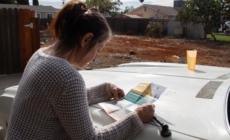-
British Pubs Are Running Out of Guinness - 8 mins ago
-
NBA Executive Sees Surprising Landing Spot For Lakers Star LeBron James - 15 mins ago
-
Authorities raid 45-ton, $100-million marijuana stash in California - 44 mins ago
-
Is Luigi Mangione Getting Fan Mail in Jail? - 50 mins ago
-
Let’s Talk About Pornography. No, Seriously. - 52 mins ago
-
7.0 quake prompts endangered Death Valley fish species to get busy - about 1 hour ago
-
Red Sox Reportedly In Talks With Orioles All-Star Free Agent Hurler - about 1 hour ago
-
A Message for Girls About Womanhood - 2 hours ago
-
Americans Have Three Day Deadline to Make Urgent Health Insurance Decision - 2 hours ago
-
Water agency board member censured for racist remark - 2 hours ago
Map Shows States With Most Diverse Teachers
More diversity among teachers is linked to more successful teaching, especially for students from racially disadvantaged backgrounds. But not all states are doing as well when it comes to their public education workforce diversity levels.
A new report from the National Council on Teacher Quality (NCTQ) showed the states with the most and least diverse teacher workforces. Based on the teacher workforce from 2018 to 2022, Washington, D.C., had the most diverse workforce, with 72.6 percent of teachers identifying as people of color.
Hawaii followed, with racial minorities making up 71.2 percent of its teacher workforce.
Also on the top 10 most diverse list were Texas, New Mexico, California, Florida, Georgia, Maryland, Mississippi and Nevada. All of those states had between 27.8 percent and 45.1 percent of their teacher workforces identify as people of color.
Some states saw substantially lower rates of diversity in their teacher workforce. The least diverse state was found to be West Virginia, with only 1.8 percent of teachers being nonwhite from 2018 to 2022. Vermont, Iowa, Idaho and New Hampshire followed, with less than 5.2 percent of the workforce composed of racial minority groups.
Nationally, the diversity of the teacher workforce is growing at a slower pace than the diversity of college-educated adults. This means more people of color are earning a higher education, but few are opting to become teachers.
“Teachers of color have a positive impact on all students—especially students of color—yet our teacher workforce continues to lack racial diversity,” NCTQ President Heather Peske said in a statement. “Addressing this issue begins with better data.”

OLIVIER TOURON/AFP via Getty Images
Jennifer Lee Magas, a communications professor at Nova Southeastern and a first-generation teacher from Bridgeport, Connecticut, has witnessed the challenges and opportunities for first-generation educators, having taught in Connecticut, Massachusetts, New York, Texas and now Florida.
“My own journey has given me a deep appreciation for the importance of representation in the classroom and the need to create pathways for more individuals from underrepresented backgrounds to enter the teaching profession,” Magas told Newsweek.
States like Texas, while being known for education policies targeting what students learn in the classroom, may actually target recruitment more effectively in partnership with historically underserved communities, Magas said.
“I noticed during my time at Texas Tech University that the faculty often reflected greater diversity than the student body, which might be attributed to these proactive efforts,” Magas said.
More liberal states might still struggle with teacher training programs and retaining diverse educators, she said.
When comparing Texas and California, for example, Texas comes out on top for teacher diversity. Roughly 43 percent of Texas’ teacher workforce was composed of people from historically disadvantaged groups in 2022. In California, the rate was roughly 33 percent.
“Looking at data and considering it further, it’s not that surprising,” HR consultant Bryan Driscoll told Newsweek. “Texas, for all its flaws, has a growing and diverse population that ends up reflected in classrooms. Meanwhile, California is choking on its affordability crisis. If teachers can’t afford to live where they teach, how can a state attract or retain a diverse workforce?”
Northeastern states like Connecticut and Massachusetts, despite being known for high-quality education programs, also had low rates of diversity when it came to their teachers as roughly only 10 percent of classrooms educators were nonwhite.
“Connecticut, for instance, has a staggering 39.3 percentage point gap between teachers of color and students of color, which has grown by 7.2 percentage points since 2014,” Magas said. “These disparities point to the need for targeted policies that improve access to teacher preparation programs and address inequities in recruitment and retention.”
Source link

















